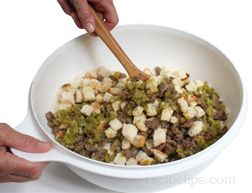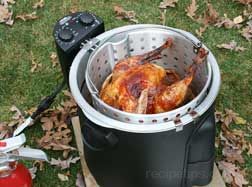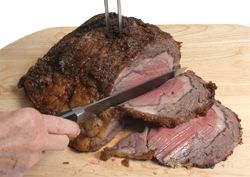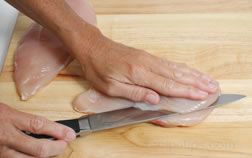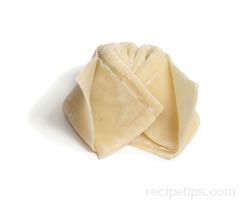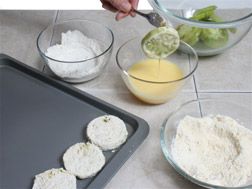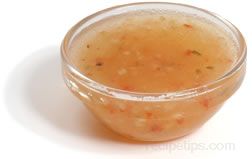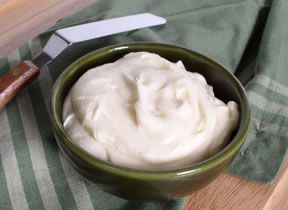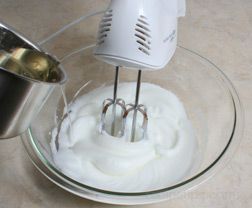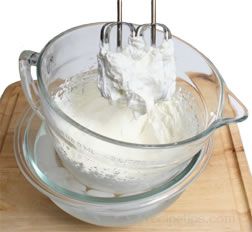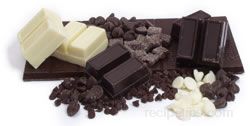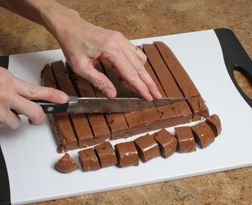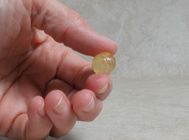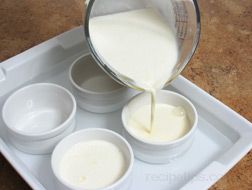|
Bakeware Pan Sizes
When you are preparing to create a recipe that requires the use of bakeware, you should first determine whether you have the proper size pan. There are many different types of bakeware, such as, round pans, square pans, rectangle pans, tube pans, bundt pans, jelly roll pans, loaf pans, springform pans, roasting pans, and casseroles. Your recipe will suggest that you use a certain size and type of pan. If you do not have the pan requested, you can generally substitute a similar size pan without any problem. The information below will help you make the appropriate substitution.
- Select a pan that is as close to the same size as the pan the recipe indicated to use. The pan should have approximately the same volume capacity and when filled, the ingredients should be close to the same depth as they would be in the original size pan. To find the surface of a pan use the equations below:
Square or
Rectangular Pans: |
|
Width x Length |
|
Total Square Inches |
|
9" x 13" |
= |
117 Square Inches |
|
|
|
|
|
| Round Pans: |
Step 1. |
Diameter ÷ 2 |
|
Radius |
|
|
9" ÷ 2 |
= |
4.5" |
|
Step 2. |
Radius x Radius x  (3.14) (3.14) |
|
Total Square Inches |
|
|
4.5" x 4.5" x 3.14 |
= |
64 Square Inches |
- If the pan is close in size and volume to the original, the cooking temperatures and times should not have to be adjusted.
- When measuring a pan, measure from inside edge to inside edge so that you are not including the thickness of the sides in your measurement. Measure the depth by placing the ruler inside the pan and measuring from the bottom up to within ¼ inch of the top edge. If the pan has slanted sides, be sure to keep the ruler straight and do not slant when measuring.
- Measure volume by filling the pan with water and then pouring the water into a measuring cup to measure how much water is in the pan, or you can also measure the water as you pour it into the pan.
- Be careful substituting a pan when the recipe indicates that a tube pan should be used, such as an angel food cake pan or a bundt pan. Generally the recipe requires this type of pan so the heat is distributed properly. This is necessary for the food to get to its proper doneness.
- If you select a glass bakeware dish or a dark, non-stick pan, reduce the oven temperature by 25°F.
- If selecting a pan that results in the depth of the ingredients to be thinner, reduce the cooking time by 10 to 15 minutes. If the depth of the ingredients is thicker, increase the cooking time by 10 to 15 minutes. Be sure to use the visual indicators to test for the proper doneness.
- If a casserole dish has to be substituted for a different size when making a savory dish, use the same guidelines as for baked goods. Use a dish that holds close to the same volume and if you substitute one that will affect the depth of the ingredients, adjust the cooking times to use less time for thinner depths and more time for thicker depths.
The chart below shows the sizes and volume of some of the common bakeware pans. The chart will help to assist you in selecting a successful substitution.
|
Bakeware Pan Sizes and Volume |
| Bakeware Pan Size |
Approximate Volume |
Bakeware Pan Size |
Approximate Volume |
| Round |
Loaf |
6" x 2"
|
4 cups |
8" x 4" x 2 1/2"
|
4 cups |
| 8" x 1 1/2" |
4 cups |
8 1/2" x 4 1/2" x 2 3/4" |
6 cups |
| 8" x 2" |
6 cups |
9" x 5" x 3" |
8 cups |
9" x 1 1/2"
|
6 cups |
Bundt |
| 9" x 2" |
8 cups |
7 1/2" x 3" |
6 cups |
| 9" x 3" |
12 cups |
9" x 3" |
9 cups |
| 10" x 2" |
11 cups |
10" x 3 1/2" |
12 cups |
Pie
|
Tube |
| 8" x 1 1/2" |
4 cups |
8" x 3"
|
9 cups |
| 9" x 1 1/2" |
5 cups |
9" x 3"
|
12 cups |
| 9" x 2" |
8 cups |
9 1/2" x 4"
|
16 cups |
| 10" x 1 1/2" |
6 cups |
10" x 4" |
16 cups |
| Square |
Tart |
| 8" x 8" x 1 1/2" |
6 cups |
11" x 1" |
4 cups |
| 8" x 8" x 2" |
8 cups |
Muffin Cup |
| 9" x 9" x 1 1/2" |
8 cups |
1 3/4" x 3/4" |
1/8 cups |
| 9" x 9" x 2" |
10 cups |
2 3/4" x 1 1/8" |
1/4 cups |
| 10" x 10" x 2" |
12 cups |
2 3/4" x 1 1/2" |
1/2 cups |
|
Rectangular |
3" x 1 1/4" |
5/8 cups |
| 11" x 7" x 2" |
6 cups |
Casserole |
| 13" x 9" x 2" |
14 cups |
1 quart |
4 cups |
| Jelly Roll |
1 1/2 quart |
6 cups |
| 10 1/2" x 15 1/2" x 1" |
10 cups |
2 quarts |
8 cups |
| 12 1/2" x 17" x 1" |
12 cups |
2 1/2 quarts |
10 cups |
| Springform |
3 quarts |
12 cups |
8" x 3"
|
11 cups |
4 quarts |
16 cups |
9" x 2 1/2"
|
10 cups |
|
|
| 9" x 3" |
12 cups |
|
|
| 10" x 2 1/2" |
12 cups |
|
|
Keep in mind, when selecting a substitution according to the pan's volume , that you need to allow room for expansion of certain foods as they cook. Certain types of food need more room for expansion than others. Fill the pan as directed by the instructions on the recipe. If you select a pan that has a comparable volume to the original size suggested by the recipe, it should allow the necessary room for expansion.
Bakeware Materials
Bakeware can be found made from several different materials. Each can have a different effect on the outcome of your baked goods. A dark colored surface on the bakeware will cause the food to brown more easily because it absorbs the heat of the oven. An aluminum pan conducts heat evenly but its shiny surface reflects the heat, resulting in food that does not brown well. Some of the common materials are shown below.
|
Aluminum

|
Aluminum is a good material for bakeware because it is a good conductor of heat, which results in even baking, but the shiny surface of the aluminum may prevent proper browning. Aluminum bakeware is durable and will not rust. For best results, look for bakeware made of a heavy-gauge aluminum rather than thinner, flimsy aluminum. The thinner bakeware may be less expensive but may warp when exposed to high temperatures, causing uneven baking. Aluminum bakeware should not be used for preparing acidic foods, such as tomato based dishes, because the acid in them and the aluminum may cause a reaction and result in food that has an off taste. It may also cause the aluminum pans to have to be replaced more often. |
| Bakeware Care: Aluminum bakeware can be cleaned with hot soapy water and if extra cleaning is required, a nylon scouring pad or a special powder cleanser made for aluminum and stainless steel can be used. |
|
Aluminum Foil

|
Constructed of a heavy gauge aluminum foil, this type of pan is used for a variety of foods and food chores such as pizza baking, bread baking, meat roasting, and numerous other cooking activities. They are generally considered to be a disposable pan, but often they can be reused if they are thoroughly cleaned after use. However, this type of pan is typically a good way to prepare baked goods and deliver them still in the pan to friends and family without worrying about the bakeware being returned. It is also a good alternative to regular bakeware or cookware when you need several pans for serving large groups of people. They work well for preparing egg, potato and casserole dishes. |
| Bakeware Care: Aluminum foil bakeware can be cleaned with hot soapy water and if extra cleaning is required, a nylon scouring pad can be used. The foil pans require careful handling to prevent them from being dented or bent out of shape. They can be cleaned in a dishwasher but to prevent denting or bending, care should be taken to not stack heavier dishes on top of them. |
|
Anodized Aluminum
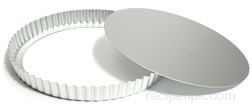
Silver Anodized
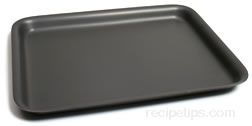
Hard Anodized
|
There are two types of anodized bakeware available, silver anodized and hard anodized bakeware. The difference between the two is explained below.
Silver Anodized - Silver anodized bakeware is made of aluminum that has gone through an electro-chemical process that hardens its outer layer. This process gives the aluminum a scratch resistant surface that is also stick resistant and it will not rust, peel or blister. The aluminum maintains its ability to conduct heat quickly and evenly, and becomes more durable. Cooking times may need to be reduced when using anodized bakeware. It is recommended to check for doneness about two-thirds through the suggested baking time. Anodized aluminum is scratch resistant but you should be careful not to use sharp knives to cut food that is baked in these pans to prevent damage to the surface.
Hard Anodized - Hard anodized bakeware is very similar to silver anodized only the aluminum is processed for a much longer period of time. This produces a hardened surface finish that is about 10 times thicker than the silver anodized. Metal utensils, other than knives, can be used on hard anodized bakeware without causing any damage to the surface. Sharp knives may cause some scoring. The hard anodized bakeware has a darkened surface, which may affect the baking time required when using this type of bakeware. Check for doneness about two-thirds through the suggested baking time. Hard anodized bakeware can be cared for in the same manner as the silver anodized. |
| Bakeware Care: Silver anodized and hard anodized bakeware should be care for in the same manner. They are easy to clean and do not rust. The bakeware should be washed by hand in hot soapy water and any stuck on food should be soaked in water to loosen. Do not wash in the dishwasher. |
|
Glass
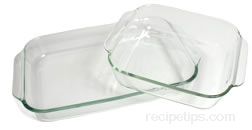
|
Glass ovenproof bakeware is made from tempered glass and conducts heat well. Food browns well in the glass ovenware. It is fairly easy to clean, does not stain, and does not react to acidic foods. Ovenproof glass can be taken from the refrigerator or freezer and placed in a hot oven, but when it is removed from a hot oven, it should be allowed to cool to room temperature before being placed in a refrigerator or freezer, and before being exposed to water. Because glass bakeware heats up faster and holds the heat longer than metal bakeware, you may want to reduce the baking temperature by approximately 25° F from what is suggested on the baking instructions for the item you are baking. Experimenting with reducing the temperature will be the best way to decide if it gives you the results you desire. |
| Bakeware Care:To care for glass bakeware, wash with hot soapy water. Stuck on food may be loosened by soaking in warm water or a nylon scouring pad can be used. Avoid using metal scrapers or abrasive cleaners. |
|
Insulated

Insulated - Top

Insulated - Bottom
|
Insulated bakeware is made of two layers of metal that are cushioned by a layer of air. The layer of air provides for even baking and browning without burning. Look for insulated bakeware with a good non-stick coating, otherwise food has a tendency to stick to the bakeware. The layers of the insulated bakeware provide more protection from the heat source than other bakeware so it heats up slower and the food does not brown as nicely. This may cause additional baking time to be necessary for properly baked food. |
| Bakeware Care: To care for insulated bakeware, use care methods according to the type of material it is made from and if it has a non-stick coating, care for it in the same manner as other non-stick bakeware. |
|
Non-Stick
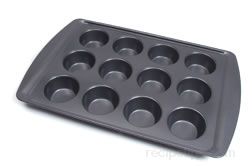
|
Non-stick bakeware consists of steel or aluminum that has had a non-stick coating applied to it. The coating allows the food to easily release from the surface of the bakeware and makes for easy clean up. Non-stick bakeware works well when you are baking items that need to be removed from the bakeware once they are done, such as muffins, cupcakes, and layered cakes. The non-stick coating gives the bakeware a darker surface, which absorbs heat more quickly than bright or lighter colored bakeware. This can cause a problem with food becoming overly browned or dried out. Baking times and temperatures may have to be adjusted to compensate for this. |
| Bakeware Care: To care for the non-stick bakeware, wash in hot soapy water and for stuck on food, soak in warm water to loosen. To prevent the coating from becoming scratched, do not use metal utensils or knives on the non-stick surface. Scratches in the coating may cause the coating to peel. |
|
Silicone
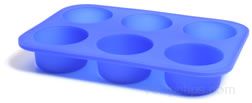
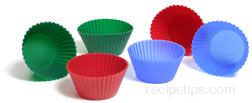
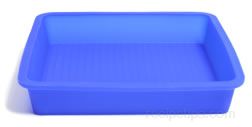 |
Silicone bakeware is a fairly new product that is used for baking molds. It is made of a flexible and bendable silicone material that can be used in the oven, microwave, and freezer. The silicone bakeware does not absorb the heat like other bakeware but allows the heat to transfer evenly to the food. The cooking process stops immediately when food is removed from the oven, preventing additional browning of the bottom and edges of the food. It can withstand temperatures ranging from minus 40 to 580 degrees F. The bakeware can be folded for convenience in storing without damaging the material. |
| Bakeware Care: The silicone bakeware is also dishwasher safe. |
|
Stainless Steel

|
Stainless Steel - Bakeware is available in stainless steel but is not recommended because it is not a good conductor of heat. It distributes heat unevenly and causes inconsistency in baked goods. |
| Bakeware Care: To care for stainless steel bakeware, wash with hot soapy water. A nylon scouring pad or nylon scraper can be used to remove stuck on food. There are stainless steel cleaners that can also be used to remove stains and bring a shine back to the stainless steel. |
|
Stone
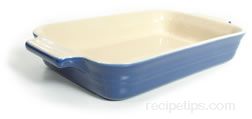
|
Stone bakeware is made from stone fired at a very high temperature. The firing of the stone produces a nonporous surface on the bakeware, which does not need glazing. The stone bakeware absorbs the heat from the oven and distributes it evenly. It retains the heat well and keeps food warm long after it is removed from the oven. Because the stone bakeware distributes heat so evenly there is less chance of burning and overcooking the food. It does take a little longer to initial heat up so if you are baking something that only requires a short baking time, you may have to extend the time by a couple of minutes. Most stone bakeware must be seasoned before using for the first time. To season, rub or spray the surface with oil. |
| Bakeware Care: To care for stone bakeware, do not use soap to clean. Scrap off excess food and wash with warm water. |
|
Tinned Steel
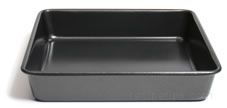 |
Tinned steel bakeware is made from sheets of steel that have been covered with a thin coat of tin, making it a good conductor of heat. The tin coating allows the bakeware to heat slowly and evenly. Tinned steel bakeware will darken after extended use, which may have an effect on baking times. |
| Bakeware Care: Special care must be taken to prevent tinned steel bakeware from rusting. It should be washed in hot soapy water and then dried thoroughly. It should then be placed in a warm oven and allowed to dry completely. Do not use metal scouring pads or abrasive materials to clean tinned steel. |
Types of Bakeware
There are many different types of bakeware available for baking a variety of baked goods. Some types are essential in producing the desired end product and some bakeware can be used for several purposes. Bakeware can be found made of many types of material, such as tinned steel, stainless steel, glass, silicone and stone. The type of material the pan is made from can have an affect on the cooking times or temperatures, requiring that they be adjusted. See Bakeware Materials above to find out which materials may affect the cooking times or temperatures. Shown below are several types of bakeware with a description and common use for each.
|
Baking Dish

Glass Baking Dish

Stoneware Baking Dish
|
A flat pan with straight sides that are ¾” or taller, which is used for baking food in the oven. There are many sizes and depths available, but the most common sizes is 9 x 13 x 2 inches. Other common sizes include: square pans 8 x 8 inches in size or rectangular pans that are 7 x 11 inches, 10 x 15 inches, and 12 x 18 inches by 1 or 2 inches in depth. Baking pans are used to hold runny batters, such as cake batter and thick solid masses of food, such as savory hot dish recipes. The foods are placed in the pan and the baked in the oven. Baking pans are available in a variety of sizes, materials, surface textures, and colors. Typical foods that are prepared in baking pans include: cakes, brownies, bars, cornbreads, lasagna, egg dishes, cobblers, potato dishes, meats, poultry, and fish. |
|
Baking Sheet

Flat Baking Sheet
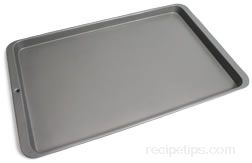
Baking Sheet with Sides
|
A flat pan or sheet of metal that is used to bake products that are thick or stiff enough to stand on their own, such as cookies, freestanding breads, biscuits, pastries, and meringues. Baking sheets, which are also referred to as cookie sheets, consist of a metal sheet that is flat with one or both of the short ends containing a slightly turned up lip that is used to aid in handling the sheets. Baking pans with ¾ inch sides all around are often referred to as baking sheets or cookie sheets also. They can be used in the same manner as a flat baking sheet but they can also be used for baking runny batters. |
|
Bread Pan (Loaf Pan)
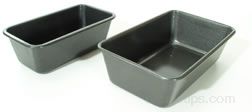
Standard Bread Pans
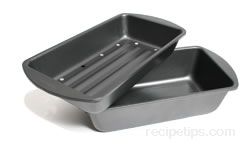
Lo-Fat Loaf Pans
|
A baking pan, rectangular in shape and deep walled, that is used to bake a single loaf of bread. Bread pans are typically made from aluminum, steel, glass, pottery, or stoneware. They are produced to make a semi-crisp crust with an evenly textured crumb, however not all pans are effective in doing so. Bread pans range in size from 5 to 14 inches in length and 3 to 5 inches in width, with a 2 1/2 to 4 inch sidewall. A standard one pound loaf pan is 8 1/2 x 4 1/2 x 2 3/4 inches in size. Smaller sized pans work well for making gift or dessert loaves that can be cooked in less time. The larger loaf pans are also often used to bake meat loaf. Bread pans are also referred to as loaf pans.
Lo-Fat Loaf Pan - A loaf pan made as two separate pans, one fitting within and above the bottom or base pan. The insert piece allows grease to drip to the lower pan and away from the food. This pan is typically used for a dish such as meat loaf but the bottom pan can be used on its own for baking bread. |
|
Brioche Pan
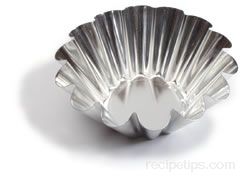 |
A type of pan or mold with fluted sides that is used to form the base of the traditional French bread known as Brioche. When making Brioche, a French dough is prepared with a light yeast and portionally larger amounts of butter and eggs. It is baked using a Brioche pan or mold to form the alternating columns on the base of the bread. |
|
Bundt Pan
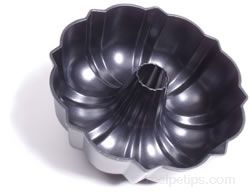
|
A heavy-walled baking pan formed with a decorative indented curvature and a hollow tube in the center. The heavier walled construction and hollow center tube allows cake batters to rise and bake more uniformly, creating a golden crust on the outside of the cake. After the ingredients are baked, the pan is turned over so the firm cake falls out onto a plate or counter, producing a decoratively shaped cake. This pan is generally used for baking coffee cakes and sweet cakes, referred to as bundt cakes. |
|
Cake Pan

Rectangular Cake Pan

Square Cake Pan
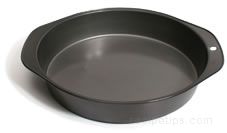
Round Cake Pan
|
A baking pan commonly found in every kitchen. Cake pans can be round, square, or rectangular and are available in several sizes. Probably the most popular is the 9 x 13 x 2 inch rectangular cake pan that is used to bake cakes, bars, and savory dishes, such as lasagna. Standard square cake pans are 8 or 9 inches wide and 1 ½ inches in depth. Round cake pans are used to make layer cakes and are generally found in 8 or 9-inch diameters and are 1 ½ inches in depth. |
|
Doughnut Pan
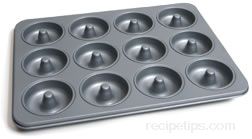
|
A pan that is constructed similar to a muffin tin except that the cups have a rounded bottom and a stem that comes up in the center of each cup to create the hole in the doughnut. The pan helps produce a lower calorie doughnut because they are baked rather than fried in oil. The doughnuts can be eaten plain or glazed, frosted, or rolled in powdered sugar. The pan is typically constructed of metal or silicone non-stick materials and is available in 6 or 12 cup sizes. It is also found spelled as Donut Pan. |
|
Flan Pan

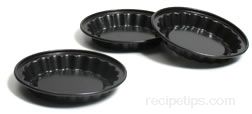
|
A shallow pan that has shallow sides that are generally fluted to provide a decorative edge to the item being baked. They are available in different materials, such as tinned steel, steel with non-stick coating and ceramic. The fluted sides of the flan pans are slightly slanted and some varieties have a loose bottom. They are available in a range of sizes between 6 and 12 inches in diameter, and they are also available in a single serving size, which range in size from 3 3/4 to 4 3/4 inches in diameter. The flan pans are used to make flans and other dishes, such as tarts, cobblers, and quiches. The small individual flan pans are used to make single serving cakes, cobblers, breads, and tarts. the flan pan is also referred to as a Maryann Pan. |
|
French Bread Pan
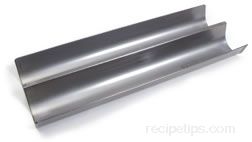
|
A type of metal or aluminum pan that is 16 to 20 inches in length and formed with a curved base so that long lengths of dough can be laid horizontally in them to be baked into baguettes. Some pans are double or triple-formed for several loaves to be baked at once. If made of metal, the pan may have numerous small holes that are perforated throughout the metal to allow steam to escape while the bread is baking in order to assist in making the crust a deeper brown in color and crispier in texture that is familiar to traditional French crust. The pan is available constructed with non-sticking metal surfaces as well as porus clay stoneware. |
|
Jelly Roll Pan

|
A large rectangular shaped baking pan with shallow sides, which generally have a rolled rim. The most common size is 10 x 15 inches but larger sizes are available, such as 12 x 17 inches and 13 x 18 inches. They have shallow sides that are 3/4 to 1 inch deep. They are found made from a variety of materials, such as aluminum, stainless steel, or steel. Many have a non-stick surface. It is designed to bake a thin cake that is coated with a layer of jelly and then rolled up into what is known as a jelly roll. It is commonly used for baking sheet cakes, cookies and pastries. |
|
Muffin Tin

Non-Stick Muffin Tin

Silicone Muffin Cups
|
A type of pan used for baking muffins. The pan typically will have 6 or 12 individual round pockets or holders connected to the tin and formed in the shape of a muffin. The muffin batter is poured into the individual pockets and as the muffin bakes, a top forms over the pocket while the base of the muffin is baked in the shape of the cup. Muffin tins are also often used to bake cupcakes. The tins are commonly available in 3 sizes ranging from those that bake a small or miniature muffin that is 1 to 2 inches in diameter, standard muffins that are 2 3/4 inches and large muffins approximately 4 inches in diameter. Individual muffin cups made from silicone are also available for baking individual cupcakes and muffins. Muffin tins may also be referred to as muffin pans. |
|
Muffin Top Pan
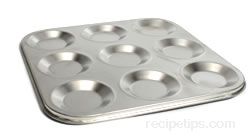 |
A muffin tin that has shallow cups that are approximately 1/2" deep. If you prefer the crusty top of the muffin, this pan will produce basically just the top of the muffin. Its shallow cups allow the top to bake up brown and crusty while eliminating the finer crumb bottom. It is available in 6 cup or 12 cup pans. This pan can also be used to bake single serving toaster cakes and individual buns. It is sometimes referred to as a bun pan. |
|
Pie Plate
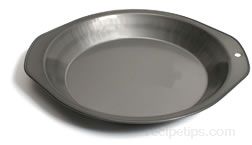
Aluminum Pie Plate
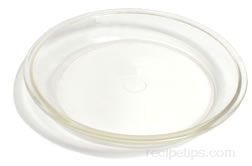
Glass Pie Plate
|
A round baking dish with shallow slanted sides that are 1 to 1 1/2 inches deep. The pie plate is available in several sizes. The most common sizes being 8, 9 and 10 inch diameters. They can be found made from many different materials, such as aluminum, glass, stoneware, ceramic, and tinned steel. Pie plates are used to bake single crust and double crust pies. They are also available in a deep dish variety that has slanted sides that are 2 to 2 1/2 inches deep and range from 9 to 11 inches in diameter. The deep dish pie plate is most often used to bake a savory dish. A pie plate is also referred to as a pie tin. |
|
Popover Pan
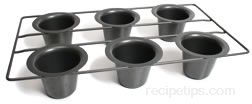
|
A baking pan or baking utensil as it may also be referred, specifically designed to hold popover batter so the popover, as it bakes, can rise up into a large, airy pastry-like shape. Larger than traditional muffin tins, the popover pan will typically be made with individual cups joined by wire racks that are constructed to hold the batter and keep the baked contents away from touching the adjacent popovers as they enlarge when baked. The cup expands outward from the base as it moves up to the top of each cup where a lip is formed. The lip seperates the base and the head of the baked popover so the base is uniform in shape and the head is allowed to bake into an irregular, puffy shaped popover, as the baked batter "pops" up and over the cup. Popover pans generally are available in several sizes, both giant and small. The number of cups included in each pan may be 4 or 6. Smaller pans may hold as many as 8 or 10 cups for individual popovers. |
|
Shortbread Pan
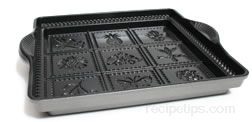
|
Constructed of a heavy cast iron or a coated aluminum surface, this type of pan is made for baking shortbread cookies. Typically made with a non-stick surface, the Shortbread pan is filled with the rich, buttery flavored dough that is baked into a tender but crumbly texture for cookies and dessert crusts. Made to produce the traditional shape that is pressed into decorative molds and baked until solid, a Shortbread Pan is contoured with square or round pattern designs that include ridges so the biscuit-like cookies can be broken apart evenly after cooking. This type of pan can bake not only shortbread cookies and biscuits, but also cakes, dessert bars, and various pan breads such as cornbread. |
|
Springform Pan 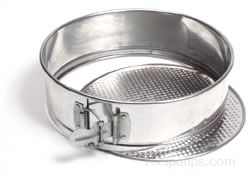 |
A round pan, with tall, straight sides that are removable. They can be found made of a variety of materials, such as tinned steel, steel, stainless steel, and carbon steel. Many have non-stick surfaces. They range in size from 8 to 12 inches in diameter with high sides of 2 1/2 to 3 inches. The most common size is a 9 or 9 1/2 inch diameter. The removable sides aid in removing cakes that would otherwise be difficult to remove, such as cheesecakes and tortes. When purchasing a springform pan, be sure the sides and base fit accurately together for a tight fit. |
|
Tart Pan
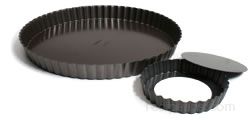
|
A round or oblong shallow pan with smooth or fluted sides and a removable bottom. The pan is constructed with a removable bottom so the baked tart can be pushed up out of the pan, allowing the contents to be removed easily and cleanly, while retaining the shape created by the fluted sides. Tart pans, which are manfactured with non-stick surfaces, are available in various sizes so tarts can be served as individual round servings or as pie-shaped servings. The small pans for individual round servings range in size from 3 to 5 inches in diameter while the larger pans for pie-shape servings commonly range in size from 9 and 11 inches in diameter. |
|
Tube Pan
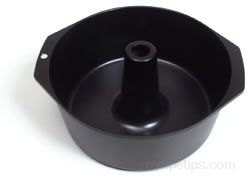
Single Piece Construction
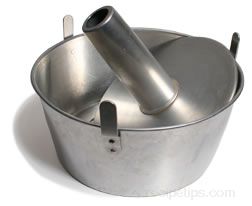
Pan with Removable Bottom
|
A deep baking pan that has a hollow tube in the center, which allows for more uniform baking. A tube pan is used for baking cakes such as angel food and sponge cake. The pan holds the ingredients and after being baked, the pan is turned over so the firm cake that has been formed into the decorative shape of the pan, falls out onto a plate or counter to be prepared for serving. Tube pans can be made as a single piece of metal or as two pieces of metal consisting of a side and a flat round bottom that is removable. Also referred to as an angel food cake pan. | |






































